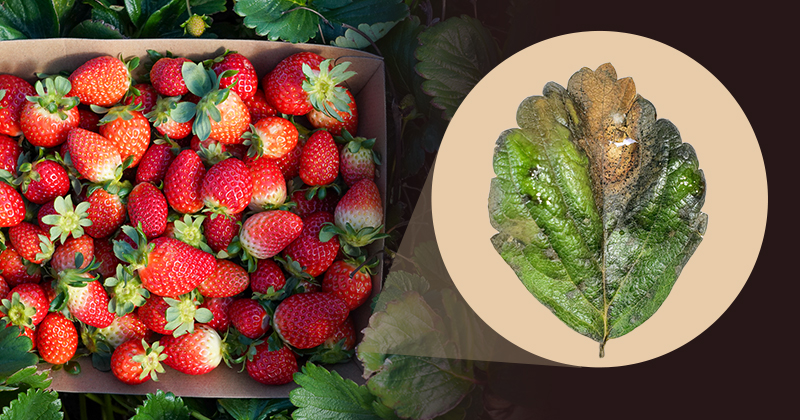


Surveilling strawberries
Photo courtesy of Jill Pollok April 16, 2025
UD Cooperative Extension specialists advise producers on emerging disease
As strawberry producers prepare for their spring harvest, some have their guard up over an emerging disease that could wipe out their crop.
Strawberry Neopestalotiopsis disease is a fungal disease that spawns brown, V-shaped lesions on strawberry leaves. It causes the fruit to rot, and ultimately can kill the plant.
“The first symptoms that I usually see in the lab are on the foliage,” said Jill Pollok, a plant diagnostician with University of Delaware Cooperative Extension. “When spores fall on the leaf and you have the right environmental conditions, you can get the disease.”
Strawberry Neopestalotiopsis disease tends to thrive in warm, humid weather amidst a prolonged wet period. The disease is relatively new to the Mid-Atlantic U.S. It’s been in the region since 2020.
Delaware’s strawberry industry is small, with 16 farms and a total of 27 acres of strawberries, according to U.S. Department of Agriculture data. The state has seen 26 detections of the disease since 2020, including 10 positive samples in 2024, but these numbers only include strawberries from producers that submitted samples to the UD Plant Diagnostic Clinic.
Pollok said the disease can spread through wind and rain, but the biggest culprit is infected transplants.
“Once the transplants are in your field, the pathogen can overwinter in crop debris,” Pollok said. “Then next year, it can proliferate from the spores that are still in your field.”
Strawberry Neopestalotiopsis disease was first found in Florida in 2017, its first introduction in the U.S., likely through contaminated plant material. Unlike other diseases, it is easy to differentiate the pathogen, Pollok said. But as it’s still relatively new to Delaware and the Mid-Atlantic, Extension professionals like Pollok are still researching the best ways to control the disease.
“If growers have any concerns, the most important thing to do when the weather warms up is scout, scout, scout,” Pollok said.
That’s exactly what Shane Marvel is doing. The Sussex County strawberry producer walks his farm fields daily, looking for any initial signs of the disease. He has 2.5 acres and two high tunnels of strawberries.
Marvel, like other strawberry producers in Delaware and the Mid-Atlantic, has been monitoring his strawberries heavily for the disease since last summer, when an outbreak happened on the Canadian province of Prince Edward Island, a major strawberry runner tip supplier to U.S. nurseries.
“My livelihood is these crops that we’re growing,” Marvel said. “We’re a first-generation farm, and we use the income from our strawberries to pay our bills.”
When Marvel first heard of the disease last August, he panicked. He thinks he may have seen the disease on his farm before, but he’s not 100 percent certain. Marvel has worked diligently to learn a lot about the disease.
“It can happen to anyone,” he said. “It’s unfortunate. It’s definitely another challenge we have to encounter, but in farming, you learn to expect it.”
Marvel gets his strawberry plugs from a Virginia nursery that imports them from Canada. He contacted the nursery to ask about the risks.
“Once I knew the plants I was getting could potentially have an issue, it was all about getting our ducks in a row to what we needed to do,” Marvel said.
Marvel called Emmalea Ernest, a fruit and vegetable specialist with University of Delaware Cooperative Extension, to find out more.
“The big question that I was dealing with late summer was ‘what can I do right now?’ Ernest said. “The more long-term questions from people are more about, ‘can we do something about this production system to help prevent this kind of problem in the future?’
Ernest said growers had three options to deal with the potential of the disease: The first was to not plant strawberries. The second, if they chose to plant strawberries last fall, was to spray fungicides more often in the fall and spring to prevent the disease. The third option was to purchase strawberry runner tips from a supplier on the West Coast, such as California, but cost- and logistics-wise, that option wasn’t feasible for everyone.
After Marvel planted his strawberry plugs last fall, he sprayed fungicides more often than normal to keep any possibility of the disease at bay. And as soon as he noticed a plant starting to wilt, he pulled it out of the ground. In spring, he will stay on a strict fungicide schedule and keep scouting his fields.
“If we see an outbreak start to occur, we will remove those plants to decrease the likelihood of spreading,” Marvel said.
Extension specialists like Ernest and Pollok advise strawberry producers to get their plants from a reputable grower. And whatever option they choose, producers should keep a careful eye on their strawberries in spring.
“When the plants come out of dormancy in the spring, they're going to put out a whole bunch of new leaves, and then they're going to start flowering and then produce fruit,” Ernest said. “We want the foliage to be healthy, because any infections on leaves can then spread to fruit later in the season.”
As the climate warms and the disease tends to thrive in warm, humid weather, it’s unclear how the disease might be exacerbated. Ernest said strawberries are clonally propagated, which means there’s a bigger chance of transferring the disease to the next generation of plants in the nurseries that supply farmers with transplants.
The U.S. Department of Agriculture has a strawberry breeding program in Maryland, working to grow strawberries that can resist the disease.
“If certain varieties are more resistant, there may be varieties that we could be growing instead of these ones that are susceptible,” Ernest said. “But researchers are still trying to answer that question.”
Contact Us
Have a UDaily story idea?
Contact us at ocm@udel.edu
Members of the press
Contact us at 302-831-NEWS or visit the Media Relations website

